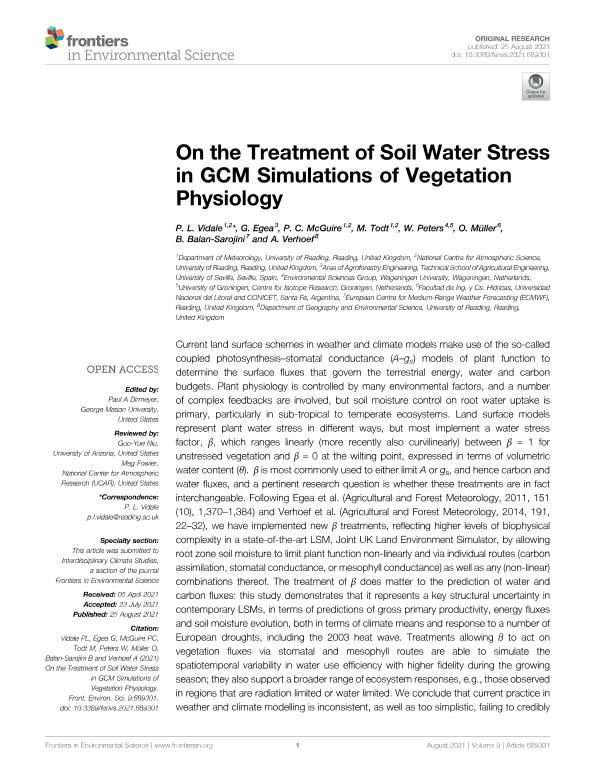Mostrar el registro sencillo del ítem
dc.contributor.author
Vidale, Pier Luigi
dc.contributor.author
Egea, G.
dc.contributor.author
McGuire, Patrick
dc.contributor.author
Todt, Markus
dc.contributor.author
Peters, Wouter
dc.contributor.author
Müller, Omar Vicente

dc.contributor.author
Balan Sarojini, B.
dc.contributor.author
Verhoef, Anne
dc.date.available
2022-09-06T11:35:11Z
dc.date.issued
2021-08
dc.identifier.citation
Vidale, Pier Luigi; Egea, G.; McGuire, Patrick; Todt, Markus; Peters, Wouter; et al.; On the Treatment of Soil Water Stress in GCM Simulations of Vegetation Physiology; Frontiers Media; Frontiers in Environmental Science; 9; 8-2021; 1-23
dc.identifier.uri
http://hdl.handle.net/11336/167477
dc.description.abstract
Current land surface schemes in weather and climate models make use of the so-called coupled photosynthesis–stomatal conductance (A–gs) models of plant function to determine the surface fluxes that govern the terrestrial energy, water and carbon budgets. Plant physiology is controlled by many environmental factors, and a number of complex feedbacks are involved, but soil moisture control on root water uptake is primary, particularly in sub-tropical to temperate ecosystems. Land surface models represent plant water stress in different ways, but most implement a water stress factor, β, which ranges linearly (more recently also curvilinearly) between β 1 for unstressed vegetation and β 0 at the wilting point, expressed in terms of volumetric water content (θ). β is most commonly used to either limit A or gs, and hence carbon and water fluxes, and a pertinent research question is whether these treatments are in fact interchangeable. Following Egea et al. (Agricultural and Forest Meteorology, 2011, 151 (10), 1,370–1,384) and Verhoef et al. (Agricultural and Forest Meteorology, 2014, 191, 22–32), we have implemented new β treatments, reflecting higher levels of biophysical complexity in a state-of-the-art LSM, Joint UK Land Environment Simulator, by allowing root zone soil moisture to limit plant function non-linearly and via individual routes (carbon assimilation, stomatal conductance, or mesophyll conductance) as well as any (non-linear) combinations thereof. The treatment of β does matter to the prediction of water and carbon fluxes: this study demonstrates that it represents a key structural uncertainty in contemporary LSMs, in terms of predictions of gross primary productivity, energy fluxes and soil moisture evolution, both in terms of climate means and response to a number of European droughts, including the 2003 heat wave. Treatments allowing ß to act on vegetation fluxes via stomatal and mesophyll routes are able to simulate the spatiotemporal variability in water use efficiency with higher fidelity during the growing season; they also support a broader range of ecosystem responses, e.g., those observed in regions that are radiation limited or water limited. We conclude that current practice in weather and climate modelling is inconsistent, as well as too simplistic, failing to credibly simulate vegetation response to soil water stress across the typical range of variability that is encountered for current European weather and climate conditions, including extremes of land surface temperature and soil moisture drought. A generalized approach performs better in current climate conditions and promises to be, based on responses to recently observed extremes, more trustworthy for predicting the impacts of climate change.
dc.format
application/pdf
dc.language.iso
eng
dc.publisher
Frontiers Media

dc.rights
info:eu-repo/semantics/openAccess
dc.rights.uri
https://creativecommons.org/licenses/by/2.5/ar/
dc.subject
HEATWAVE 2003
dc.subject
INTERNAL CO2 CONCENTRATION
dc.subject
PHOTOSYHTHESIS
dc.subject
SOIL MOISTURE
dc.subject
STOMATAL CONDUCTANCE
dc.subject.classification
Investigación Climatológica

dc.subject.classification
Ciencias de la Tierra y relacionadas con el Medio Ambiente

dc.subject.classification
CIENCIAS NATURALES Y EXACTAS

dc.title
On the Treatment of Soil Water Stress in GCM Simulations of Vegetation Physiology
dc.type
info:eu-repo/semantics/article
dc.type
info:ar-repo/semantics/artículo
dc.type
info:eu-repo/semantics/publishedVersion
dc.date.updated
2022-08-30T20:02:30Z
dc.identifier.eissn
2296-665X
dc.journal.volume
9
dc.journal.pagination
1-23
dc.journal.pais
Suiza

dc.description.fil
Fil: Vidale, Pier Luigi. University of Reading; Reino Unido
dc.description.fil
Fil: Egea, G.. Universidad de Sevilla; España
dc.description.fil
Fil: McGuire, Patrick. University of Reading; Reino Unido
dc.description.fil
Fil: Todt, Markus. University of Reading; Reino Unido
dc.description.fil
Fil: Peters, Wouter. Wageningen University; Países Bajos
dc.description.fil
Fil: Müller, Omar Vicente. Universidad Nacional del Litoral; Argentina. Consejo Nacional de Investigaciones Científicas y Técnicas. Centro Científico Tecnológico Conicet - Santa Fe; Argentina
dc.description.fil
Fil: Balan Sarojini, B.. European Centre for Medium-Range Weather Forecasting; Reino Unido
dc.description.fil
Fil: Verhoef, Anne. University of Reading; Reino Unido
dc.journal.title
Frontiers in Environmental Science
dc.relation.alternativeid
info:eu-repo/semantics/altIdentifier/doi/http://dx.doi.org/10.3389/fenvs.2021.689301
Archivos asociados
